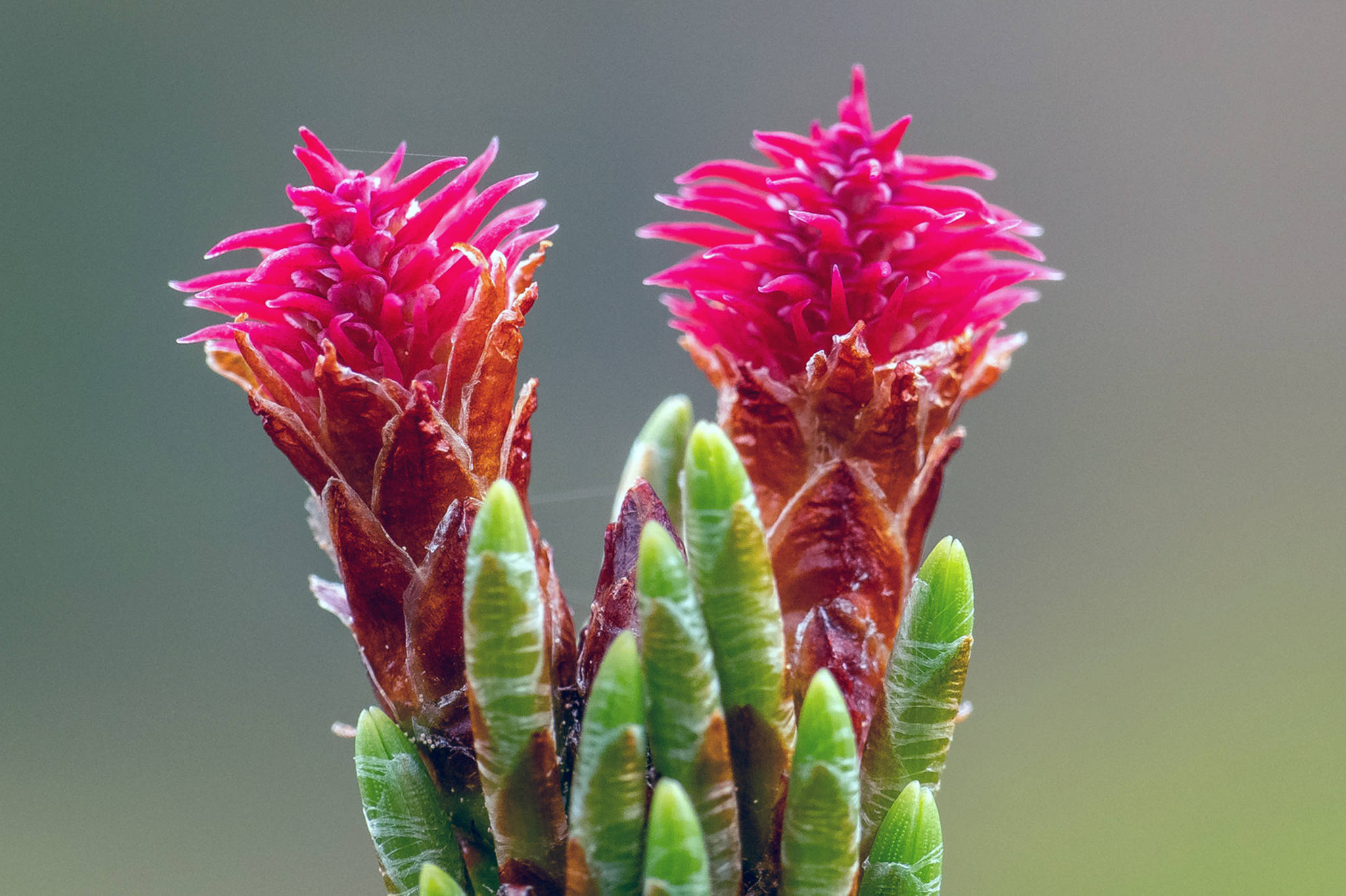In early June, I went with a few friends to check out some muskegs at Eaglecrest. In addition to the common round-leaf sundew, we found some long-leaf sundews already making flower buds. Both of these diminutive species supplement their income by capturing hapless small insects on sticky hairs on their leaves and digesting their victim’s juices. There seem to be minor differences in their preferred habitats: longleafs are more likely to grow on soils less densely covered by mosses and other plants. For some reason, perhaps habitat availability in part, longleafs seem to be much less common than the other sundew.
Sundews are not our only insectivorous plants. Butterworts grow in the meadows on Douglas, for example, and in the subalpine meadows on Gold Ridge. Their leaves are sticky traps for insects.
Bladderwort is a delicate, fragile aquatic plant sometimes found in muskeg ponds; it captures tiny aquatic creatures in ingenious little bladders with a narrow opening. The opening of each bladder is guarded by trigger hairs; when disturbed by a passing crustacean or insect, the triggers signal the bladder to open. The walls of the bladder are held inward under tension, but when triggered, the walls expand, and the lowered pressure inside the bladder sucks in the victim. Nifty!
While we were exploring the Eaglecrest muskegs, we also noticed that some of the shore pines bore tiny red rosettes near their growing tips, usually on the upper branches. What???? Not some other organism that has taken up residence there. I was sure I’d seen these bright rosettes before, but any knowledge of them seemed to have fallen through the ever-widening cracks in what used to be my memory. However, after a bit of discussion, we settled on the right answer — these are brand new seed cones! Other shore pines bore clusters of pollen-producing male cones, just at the right time to pollinate the new cones.
Reproduction in pines is a complex business that includes many seemingly strange delays. The new seed cones were initiated the previous fall but don’t emerge as rosettes until spring. Only the upper scales of the red rosettes bear fertile ovules. When the scales of the rosette open up, a drop of fluid appears near the ovule; this is called a pollination drop. It lasts two to four days, and then it is withdrawn, pulling in any pollen brought in by the wind. The rosette scales then enlarge and close; the receptive period is over.
However, the pollen does not germinate immediately, and fertilization of ovules occurs about a year after pollination. Then the embryos develop over the following year, and the seed is filled with food for the seedling. However, pollen from another individual tree is more likely to result in viable, filled seeds than pollen from the same individual. Then the seed cone scales enlarge, and after two full years, the seed cone is mature and ready to shed its seeds.
So, if (and that’s a big if) a twig makes a cone or two every year, observers might see the red rosette at the tip, then a small cone or two where last year’s shoot tip was, and below that, a mature cone ready to shed seeds in fall. Older cones that have long since shed their seeds may still cling to the twig farther down.
Shore pine cones take two years to mature, but there are other kinds of pines in which cone development takes even longer, as much as six years! But why?? For comparison, seed cones in spruce and hemlock mature in the year they are pollinated. What ecological factors account for the great differences in the “strategies” of cone maturation among all these related conifers?
A few days later, a beautiful brown spider, with gold stripes on its long abdomen, clung to the top of a beach-rye seed head. As I watched, it crept out into the space on the eight-inch journey to another seed head, seeming to walk on air. I could see that two of its legs were prodigiously long, far longer than the other six. Then it fussed about on the second seed head for a short while, moved down an inch or two, and slowly came back to the first seed head. Of course there must have been some silk strands in place, but I could not see them from any angle of view, they were so fine. The diligent spider then seemed to lay down some vertical strands across the existing horizontal ones, working on an invisible web. I would like to know how the first horizontal threads were laid down across that sizable gap. I don’t know her name, so I can’t look up anything about this lovely beastie.
The next week, I perched on a log in the sun, with a clump of beach pea on one side and a stand of lupine on the other. Several small worker bumblebees visited the lupines, erratically checking out a flower here or there on different inflorescences, zooming off a little way and then returning. Occasionally, one would open a flower, pressing down on the lower lip, but never stayed more than about one second. Was that time enough to sip some nectar or was this a sign that no reward was available? If nectar rewards were present, why were the visits so erratic?
What a contrast with the behavior of a big, fat queen bee, who was all business. She went straight to the beach peas and systematically visited every open or nearly open flower in the clump. Her behavior suggested to me that she was regularly rewarded for her visits — otherwise, why stay?
• Mary F. Willson is a retired professor of ecology. “On The Trails” is a weekly column that appears every Friday. Her essays can be found online at onthetrailsjuneau.wordpress.com.

